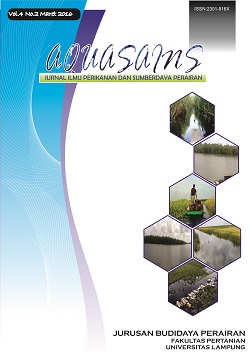The Effect of Sex Reversal Using 17α-Methyltestosterone Hormones Towards The Colour Intensity of Male XX And Female XYFighting Fish (Betta Sp.)
Abstract
Fighting fish (Betta sp.) is endemic fresh water fish of Southeast Asia that has become one of Indonesias export commodities. Male fighting fish has brighter colour then the female. Mono-sexual male fighting fish population can be obtained through sex reversal method (female to male). However, male fighting fish suspected sex reversal results will likely have a low color intensity. This study aims to determine the effect of sex reversal using 17α-methyltestosterone hormone toward colour intensity of male fighting fish with XX genotype as the results of sex reversal and the original male fighting fish XY genotype. The research design consisted of 2 treatments with 3 replications. The determination of the observations grade toward the colour intensity of fighting fish is done by comparing the original colour of the fish using coloured paper Modified Toka Colour Finder (M-TCF) which were observed by 5 observers for the accuracy of the data. The results showed that there is significant effect of sex reversal using 17α-methyltestosterone hormone toward the colour intensity of the male fighting fish XX to XY males. On the whole, the mean observed colour intensity for P1 (with sex reversal) is 18.33 and P2 (without sex reversal) is 28.33, it shows that the P1 has lower brightness than P2.
Downloads
Downloads
Published
How to Cite
Issue
Section
License
License for Authors
Authors who publish with this journal agree to the following terms:
- Authors retain copyright and grant the journal right of first publication with the work simultaneously licensed under a Creative Commons Attribution License that allows others to share the work with an acknowledgement of the work's authorship and initial publication in this journal.
- Authors are able to enter into separate, additional contractual arrangements for the non-exclusive distribution of the journal's published version of the work (e.g., post it to an institutional repository or publish it in a book), with an acknowledgement of its initial publication in this journal.
- When the article is accepted for publication, its copyright is transferred to Aquasains Journal. The copyright transfer convers the exclusive right to reproduce and distribute the article, including offprint, translation, photographic reproduction, microfilm, electronic material, (offline or online) or any other reproduction of similar nature.
- Authors are permitted and encouraged to post their work online (e.g., in institutional repositories or on their website) prior to and during the submission process, as it can lead to productive exchanges, as well as earlier and greater citation of published work (See The Effect of Open Access).
- The Author warrant that this article is original and that the author has full power to publish. The author sign for and accepts responsibility for releasing this material on behalf os any and all-author. If the article based on or part os student’s thesis, the student needs to sign as his/her agreement that his/her works is going published.
License for Regular Users
Other regular users who want to cite, distribute, remix, tweak, and build upon author’s works, even for commercial purposes, should acknowledge the work’s authorship and initial publication in this journal, licensed under a Creative Commons Attribution License.
This license lets others distribute, remix, tweak, and build upon your work, even commercially, as long as they credit you for the original creation.
This work is licensed under a Creative Commons Attribution 4.0 International License.Copyright Transfer Statement can be downloaded here


.png)









